![]()
![]()
![]()
Use LEFT and RIGHT arrow keys to navigate between flashcards;
Use UP and DOWN arrow keys to flip the card;
H to show hint;
A reads text to speech;
145 Cards in this Set
- Front
- Back
|
Skeletal muscle is composed of...?
|
Muscular and Connective tissue
|
|
|
Muscle fibers are surrounded by...?
|
a layer of areolar connective tissue called endomysium
|
|
|
What is loose connective tissue...?
|
gel-like ground substance found between cells
|
|
|
Muscle fibers are surrounded by...?
|
a layer of areolar tissue called endomysium
|
|
|
Bundle of muscle fibers are called?
|
fasicle
|
|
|
What separates the fasicles
|
thick connective tissue called perimysium
|
|
|
Epimysium is...?
|
connective tissue that covers entire muscle and protect muscles from friction against other muscles and bones
|
|
|
Deep fascia is...?
|
connective tissue found between adjacent muscles
|
|
|
Superficial fascia(hypodermis) is...?
|
is adipose found between muscles and skin
|
|
|
Tendons contain(only collagen, no elastic fibers)
What do they do? |
attach bone to muscle
|
|
|
What are ligaments...?
|
Attach bone to bone
|
|
|
Tendons contain collagen fibers that are...?
|
densely packed into parallel bundles
|
|
|
Endomysium
|
thin areolar tissue around muscle fibers, allow room for nerve fibers and capillaries
|
|
|
Perimysium
|
thick layer of connective tissue surrounding fasicles
|
|
|
Epimysium
|
covers whole muscle and blends into connective tissue sheets between muscles
|
|
|
properties of collagen?
|
extensible and elastic allowing it to stretch slightly and recoil backprotecting muscle from injury and returning it back to its normal length
|
|
|
slide title: origin of skeletal muscle striation
|

|
|
|
s
|
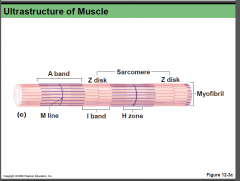
|
|
|
Elastic filaments contain
|
springy proteins called titin
anchor each thick filament to Z disc prevents overstretching of sarcomere |
|
|
How do muscle cells shorten?
|
There sarcomeres shorten, pulling z-discs closer together
|
|
|
neither thick nor thin filaments change length during shortening
|
s
|
|
|
spinal chord> motor neurons attached to spinal chord attach to muscle fibers at neuromuscular junctions
|
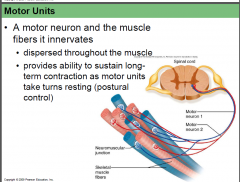
|
|
|
For fine control
|
there are 20 muscle fibers per nerve fiber
ex. eye muscles |
|
|
for strength contorl
|
there are 100 muscle fibers per nerve fiber
ex. gastrocnemius muscle |
|
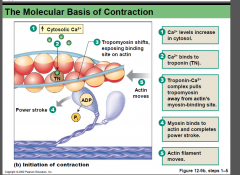
Molecular basis of contraction steps:
|
1.) Ca2+ levels increase in cytosol
2.) Ca2+ binds to troponin 3.) Troponin-Ca2+ complex pulls tropomyosin away from actin's myosin-binding site 4.) Myosin binds to actin and completes powerstroke 5.) Actin filament moves |
|
|
pic
|
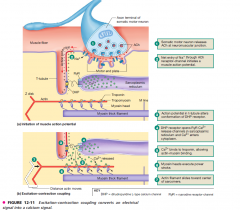
|
|
|
synapse
|
connection between nerve fiber and target cell
|
|
|
synapse is also called neuromuscular junction, why?
|
this is when there is a connection between a nerve fiber and a muscle cell
|
|
|
Which neurotransmitter is released from the nerve fiber? What does it do?
|
acetylcholine/ACh. Stimulate muscle cell
|
|
|
synaptic knob
|
swollen end of nerve fiber that contains ACh
|
|
|
synaptic cleft
|
area between nerve cell and muscle cell
|
|
|
what do junctional folds of sarcolemma do?
|
increase surface area for ACh receptors, they contain acetylcholinesterase that breaks down ACh and causes relaxation
|
|
|
Basil lamina
|
thin layer of collagen and glycoproteins that cover muscle fibers
|
|
|
What do schwann cells do?
|
isolate neuromuscular junctions from the outside
|
|
|
neuromuscular junction
|
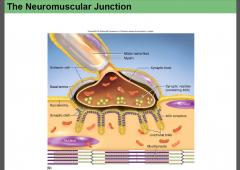
|
|
|
What kind of proteins are myosin and actin?
|
contractile proteins
|
|
|
Tropomyosin and troponin are what kind of proteins
|
regulatory proteins
|
|
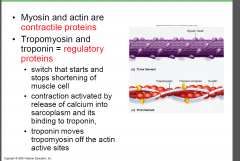
|
tropomyosin and troponin are like a switch that starts and ends shortening of muscle cell.
-contraction activated by release of calcium into sarcoplasm and it binds to troponin -binding of calcium to troponin causes tropomyosin to move off the actin active sites -myosin head then binds |
|
|
What causes the resting membrane potential?
|
Na+ out of cell and K+ and other anions inside of cell
|
|
|
What is the difference in charge across the membrane potential referred to as? and what value?
|
resting membrane potential
-90 mV |
|
|
What opens ion gates in membrane? What happens?
|
Stimulation, Depolarization, Na+ rushes in , K+ rushes out
|
|
|
What is an action potential?
|
Quick up and down voltage shift, which spreads over cell surface as nerve signal
|
|
|
What are the actions involved in muscle contraction and relaxtion?
|
excitation= nerve action potentials leads to action potentials in muscle fiber
excitation-contraction coupling= action potentials on sarcolemma activate myofilaments contraction=shortening of muscle fibers relaxtion=return to rest length |
|

|
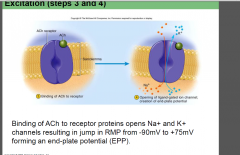
|
|
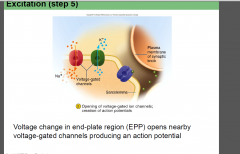
|
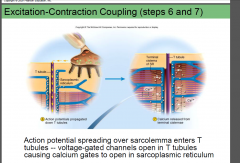
|
|
|
rest of steps in above is in slides rigor mortis is? |

|
|
|
when a tricep muscle relaxes the bicep muscle contracts(antagonistic muscle groups; arm flexion)
|
when a tricep muscle contracts, the bicep muscle relaxes(antagonistic muscle groups; arm extension)
|
|
|
What is the tension-length relationship
|
the amount of tension generated depends on length of muscle before it was stimulated
|
|
|
What happens in overly contracted muscles?
|
thick filaments get too close to z-discs and cant slide
|
|
|
What happens in too stretched muscles?
|
thick and thin filaments don't overlap enough and not many cross bridges form
|
|
|
What is optimum resting length?
|
the length that produces the most tension when contracted
|
|
|
muscle twitch,
what is threshhold? |
the voltage at which an action potential is produced
|
|
|
What is a muscle twitch?
|
produces a quick contraction and relaxtion lasting less than 1/10th of a second
|
|
|
Are muscle twitches useful?
|
No, the contraction isn't strong enough to do any useful work(not enough Ca2+)
|
|
|
What produces twitches?
|
Threshhold stimuli
|
|
|
Is the statement muscle fiber obeys an all or non law, contracting to its maximum or not at all true?
|
No, because muscle twitches vary in strength depending on Ca2+ concentration, temperature, pH and hydration
|
|
|
How do we get stronger contractions?
|
stimulate the nerve with stronger voltages
-more motor units are being recruited and this is called motor unit summation ex.lifting a glass of milk vs lifting a gallon of milk |
|
|
What happens to muscle twitch at low frequency?
|
each stimulus produces an identitical twitch response in tension
|
|
|
What happens to muscle twitch at moderate frequency?(called treppe )
|
each preceding twitch produces a stronger twitch response in tension, this is because calcium was not completely put back into the sarcoplasmic reticulumn
|
|
|
What happens to muscle twitch at high frequency?
|
generates gradually more strong contraction, stimuli arrives before last one recover
called incomplete tetanus |
|
|
What happens to maximum frequency stimulation?
|
muscle has no time to relax at all
twitches fuse into smooth prolonged contraction called complete tetanus |
|
|
What is isometric muscle contraction?
|
develops tension without changing length
tension on muscle without changing length |
|
|
What is isotonic muscle contraction?
|
tension on muscle but changes length develops tension while shortening = concentricdevelops tension while lengthening= ecentric |
|
|
What do muscles need in order to contract?
|
muscles need ATP in order to contract
|
|
|
What are some ways muscle can produce ATP?
|
Anaerobic fermentation and aerobic respiration
|
|
|
What is anaerobic fermentation?
|
Produces limited ATP, without oxygen and produces toxic lactic acid as a result
|
|
|
What is aerobic respiration?
|
Produces ATP, with oxygen, produces H2O and CO2
|
|
|
For a short intense exercise, where is oxygen obtained from?
|
Myogloblin
|
|
|
For a short intense exercise, how it ATP produced?
|
Through the Phosphagen system:
myokinase transfers phosphate groups from one ADP to another forming ATP creatine kinase transfer phosphate groups from creatine phosphate to ADP forming ATP |
|
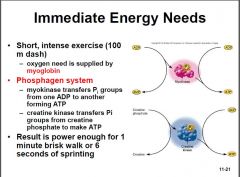
What is the result of the phosphagen system?
|
Enough power for 1minute brisk walk or 6 seconds of sprinting(immediate energy needs)
|
|
|
What do you use for short term energy needs
? |
anaerobic fermentation
|
|
|
What does anaerobic fermentation do?
|
produces ATP for the 30-40 seconds(running around baseball diamond)
muscles obtain glucose from blood and glycogen |
|
|
What is used for long term energy needs?
|
Aerobic respiration?
|
|
|
How many ATP molecules are produced per glucose?
|
36ATPs/glucose
|
|
|
After 40 seconds of exercise, respiratory and cardiovascular systems must deliver enough oxygen for aerobic respiration
|
oxygen intake rate increases for first 3-4minutes and then levels off
|
|
|
muscle metabolism
aerobic respiration>phosphagen system>anaerobic fermentation>aerobic respiration |

|
|
|
What is fatigue
|
progressive weakness from use
|
|
|
Why does fatigue occur?
|
ATP synthesis declines as glycogen is consumed
lactic acid buildup inhibits enzyme function hyperpolarization as too much K+ accumulates outside cell motor nerve fibers use up their acetylcholin |
|
|
What is endurance?
|
The ability to maintain high intensity exercise for >5minutes
|
|
|
What is endurance determined by?
|
Maximum oxygen uptake
|
|
|
What is maximum oxygen uptake proportional to?
|
body size, peaks at age 20 and is larger in trained athletes and males
|
|
|
What is endurance determined by?
|
nutrient availability
some atheletes load carbohydrates, which pack glycogen in muscle cells |
|
|
Heaving breathing after exercise is referred to as?
|
excess postexercise oxygen consumption (EPOC)
typically 11litres extra is consumed |
|
|
What is the purpose for extra oxygen after streneous exercise?
|
replace oxygen reserves(hemoglobin, myoglobin)
replenishing the phosphagen system reconverting lactic acid to glucose in kidneys and livers |
|
|
slow twitch fibers
|
have more mitochondria, myoglobin, and capillaries
adapted for aerobic respiration and resistant to fatigue |
|
|
fast twitch fibers
|
rich in enzymes for phosphagen and anaerobic systems
sarcoplasmic reticulumn releases calcium quicker so contractions are quicer -eye muscles, biceps, gastrocnemius(calves) |
|
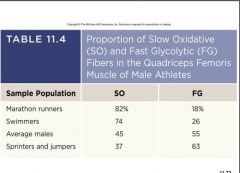
|
look
|
|
|
resistance training stimulates cell enlargement due to?
|
synthesis of more myofilaments
|
|
|
Endurance training produces more?
|
mitochondria, glycogen, and density of capilaries: produces less fatigue
|
|
|
What are cardiac and smooth muscle cells called?
|
myocytes, short cells with one nucleus
|
|
|
Cardiac muscles are linked to eachother through?
|
intercalated discs
|
|
|
They have what kinds of junctions?
|
eletrical junctions and mechanical junctions
electrical allow cells to stimulate their neighbours mechanical prevent the cells from pulling apart |
|
|
What are damaged cardiac muscle cells repaired by?
|
fibrosis
|
|
|
Cardiac muscle uses
|
aerobic respiration exclusively, and have large mitochondria that make it resistant to fatigue
|
|
|
Smooth muscle cells
|
used for swallowing, GI tract functions, labor contractions, erection of hair, control of pupils
|
|
|
smooth muscle
|
contraction and relaxtion slower
uses less energy maintains for for long perioids low oxygen cosumption |
|
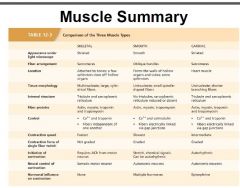
|
muscle summary
|
|
|
airflow in lungs goes from br
|
bronchi>bronchioles>alveoli
|
|
|
Conducting division: passages for airflow
|
nostrils to bronchioles
|
|
|
Overview of external and cellular respiration
|

atmosphere>lungs>blood>transport in blood>cells
|
|
|
Branching of airways: larynx>trachea>cartilagering>primary bronchus>secondary bronchus>bronchiole>alveoli
|
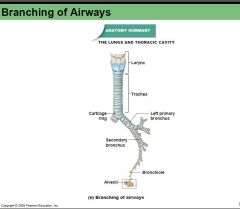
|
|
|
Respiratory system overview
|
Respiratory system moves air into and out of lungs and provides a surface for gas exchange
|
|
|
The upper respiratory tract consists of
|
nose, nasal cavity, pharynx
|
|
|
The lower respiratory tract includes
|
larynx, trachea, bronchi, and lungs
|
|
|
Inhaled air enters the nasal cavity, what happens here?
|
its warmed and humidified
|
|
|
After the nasal cavity where does it go?
|
The pharynx
|
|
|
What is the pharynx?
|
Shared region of the respiratory and digestive system
|
|
|
Where does it go after the pharynx?
|
the cartilaginous larynx, where there is the vestibular and vocal folds
|
|
|
What do the vestibular folds do?
Vocal folds? |
prevent foreign particles from entering the respiratory system
produces sound |
|
|
Air then enters the trachea, what is the trachea?
|
10-12cm long tube supported by C-shaped cartilages which maintains open passageway to and from lungs
|
|
|
Trachea divides at the carina forming?
|
two primary bronchi
|
|
|
Where are the bronchi found?
|
the lungs, they continue to divide into smaller and smaller bronchi and ultimately into terminal bronchioles
|
|
|
What happens to terminal bronchiole?
|
they divide to form aveolar ducs, sacs, and respiratory bronchioles
|
|
|
What are alveolar sacs connected to?
|
Group of alveoli
|
|
|
What are alveoli surrounded by?
|
pulmonary capilaries
|
|
|
What do alveoli and capillaries do?
|
use their ultra thin wall surface for gas exchange between air and blood
|
|
|
Where does oxygen and co2 go?
|
Oxygen diffuses across this membrane into blood, CO2 diffuses across this membrane from the blood into the air where it is expelled during exhalation
|
|
|
ciliated respiratory epithelium
|

|
|
|
Alveolar structure
What do Type 1 alveolar cells do? Type 2 alveolar cells? Alveolar macrophages? |
gas exchange
synthesizes surfactant ingests foreign material |
|
|
ventilation of lung
|
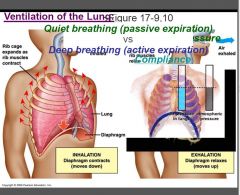
|
|
|
pnemothorax
|
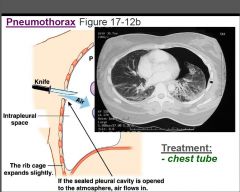
|
|
|
Measuring ventilation of lung
|
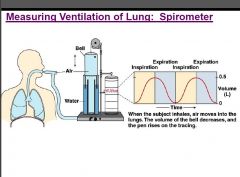
|
|
|
Pulmonary ventilation(breathing) includes?
|
inspiration and expiration
|
|
|
What results from inspiration and expiration?
|
change in volume of the thoracic cavity causes inspiration and expiration
|
|
|
What causes change in thoracic cavity?
|
respiratory muscles that occur in three dimensions
|
|
|
During inspiration what happens to thoracic cavity?
|
It increases in volume to accomodate expansion of lungs
|
|
|
How does it increase in volume?
|
the diaphragm flattens and descends
|
|
|
During expiration what happens to the thoracic cavity?
|
|
|
|
What affects the depth and width of the thoracic cavity?
|
intercostal muscles that elevate and depress the ribs and sternum
|
|
|
What does elevation of the ribs do?
|
increases thoracic cavity width
|
|
|
What happens to the sternum as the ribs elevate?
|
they move anteriorly and superiorly increasing depth
|
|
|
23-33 slides
|
https://myclass.ufv.ca/bbcswebdav/pid-257283-dt-content-rid-1146466_1/courses/10121.201501/10121.201501_ImportedContent_20150106085627/alveolar_pressure_chang.swf
|
|
|
Chapter 18: gas exchange and transport
|

|
|
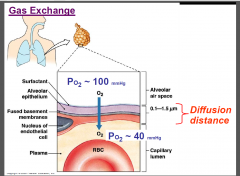
|
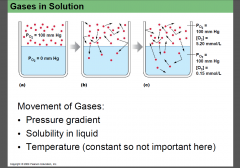
|
|
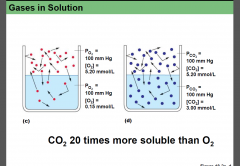
|
alveoli-site of gas exchange
|
|
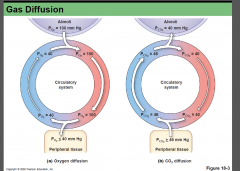
|
s
|
|
|
Structure of hemoglobin is?
|

-has 4 subunits each, centered around Fe2+
|
|
|
oxygen transport
|

|
|
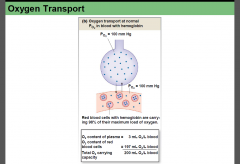
|
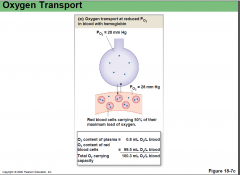
|
|
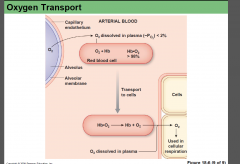
|
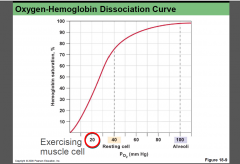
|
|
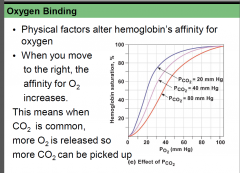
|

|
|
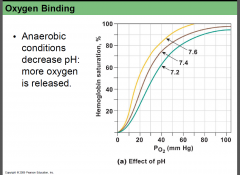
|
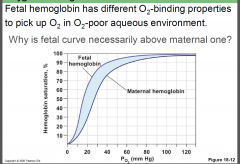
|
|

|
slide 20-31, human phys chapt18
|
|
|
s
|
s
|
|
|
s
|
s
|

